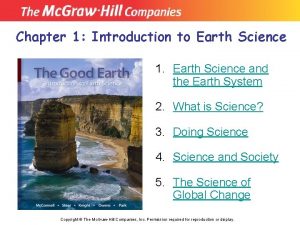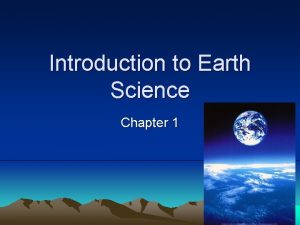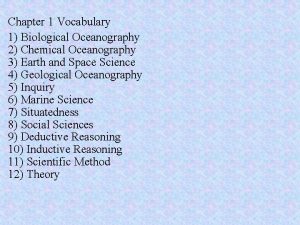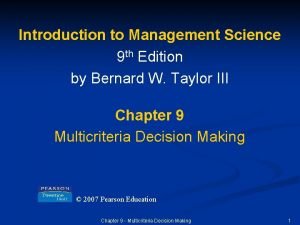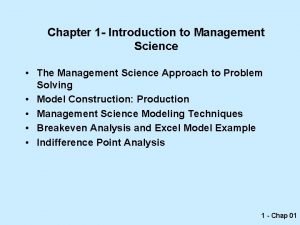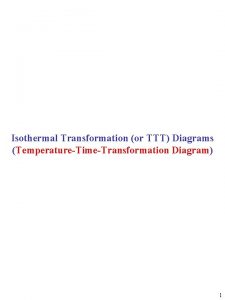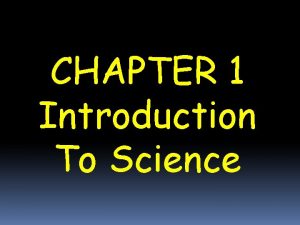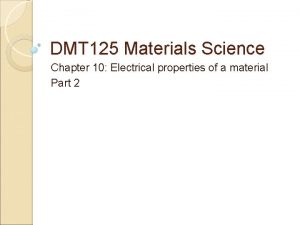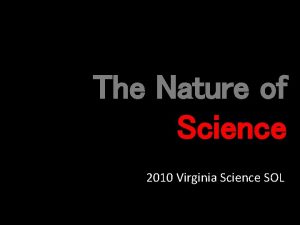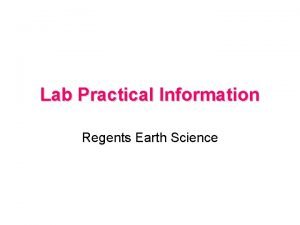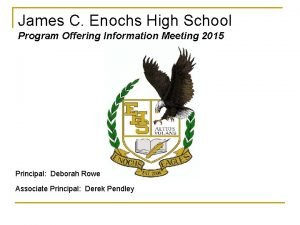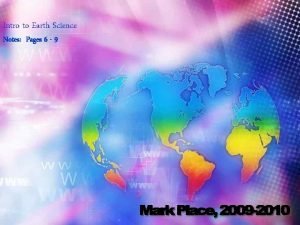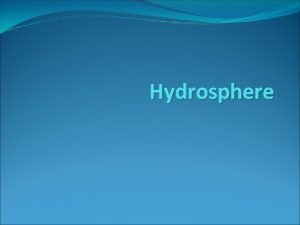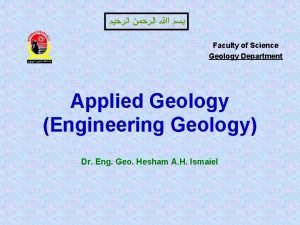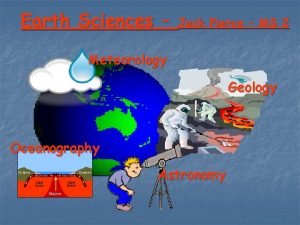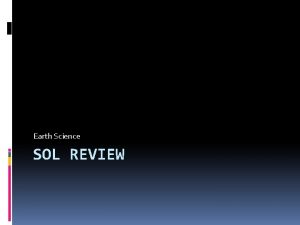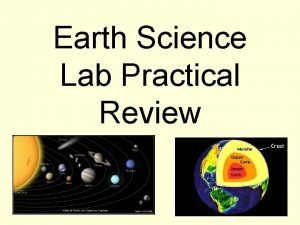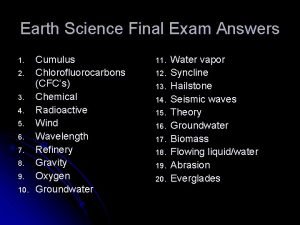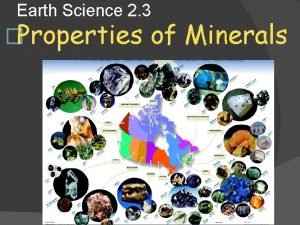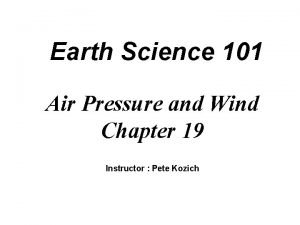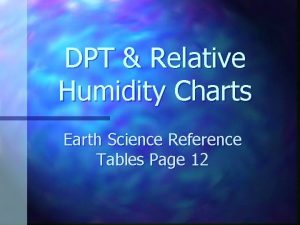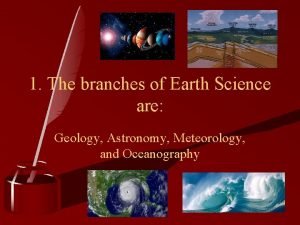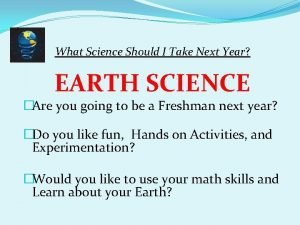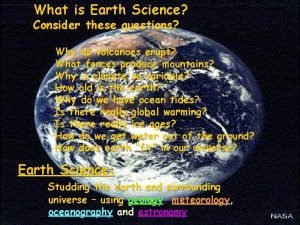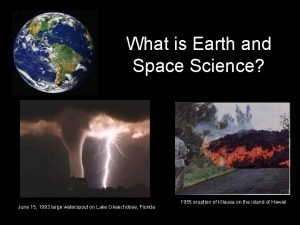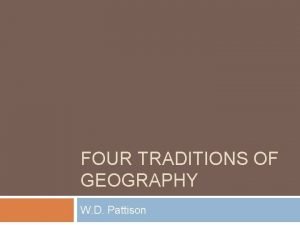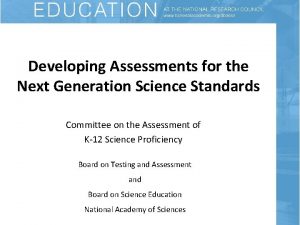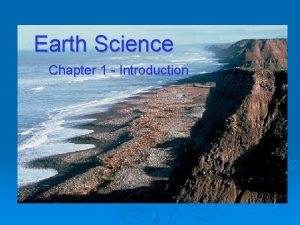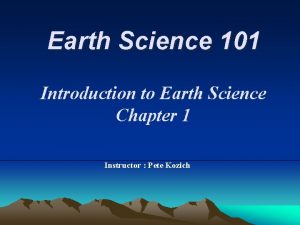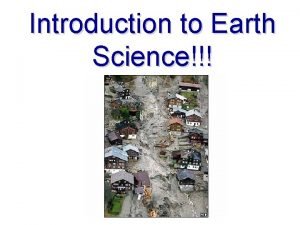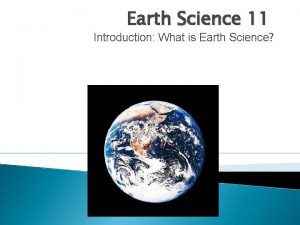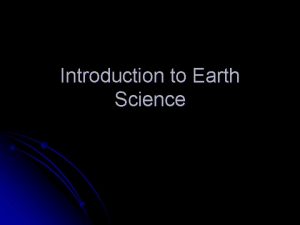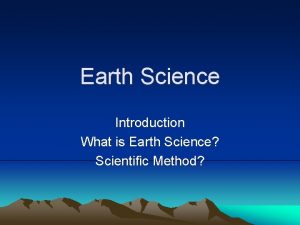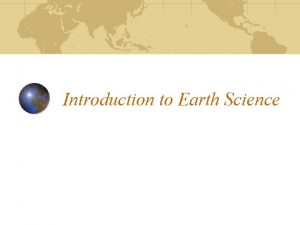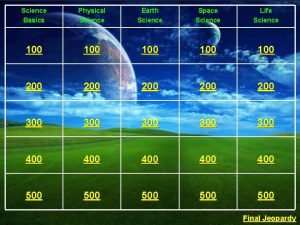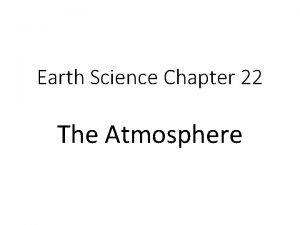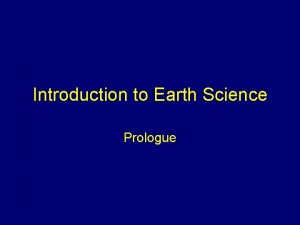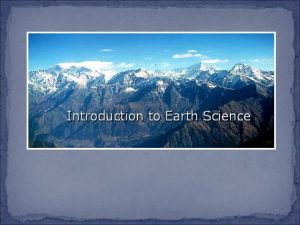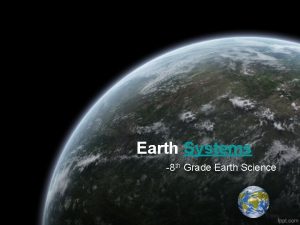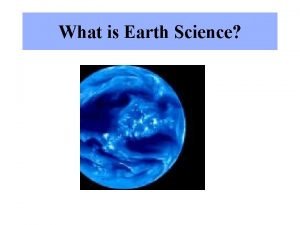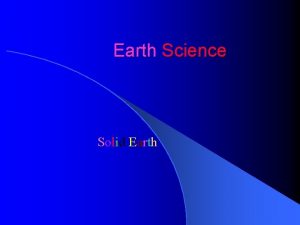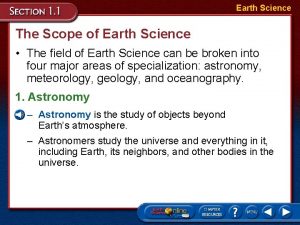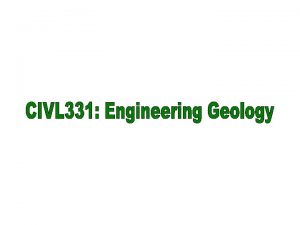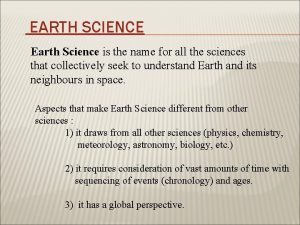Chapter 1 Introduction to Earth Science 1 Earth








































- Slides: 40

Chapter 1: Introduction to Earth Science 1. Earth Science and the Earth System 2. What is Science? 3. Doing Science 4. Science and Society 5. The Science of Global Change Copyright © The Mc. Graw-Hill Companies, Inc. Permission required for reproduction or display.

Learning Objectives • • • Students will explain concepts related to science and scientific investigation. Students will identify examples of inductive and deductive reasoning. Students will identify rules of good science and recognize when these rules are being applied. Students will differentiate between an observation, prediction, hypothesis, and theory. Students will give examples of the principal roles that Earth scientists play in society. Students will discuss issues related to global change.

Are you ready for a natural disaster? A giant earthquake buckles the seafloor just west of Indonesia at 7. 58 a. m. , December 26, 2004 Several hours later waves struck African coastlines A tsunami strikes the beach at Phuket Island a few hours after the earthquake Banda Aceh, Sumatra, Indonesia, was quickly devastated by waves up to 30 meters high More then 230, 000 people are estimated to have died following the earthquake and tsunami

Earth Science and the Earth System Earth Science • The investigation of interactions among the four components of the Earth system. . . – – atmosphere (air, weather) hydrosphere (water, ice) biosphere (plants, animals) geosphere (land, rocks) • . . . and their interaction with the exosphere (sun, space). The Good Earth, Chapter 1: Introduction to Earth Science

Earth Science and the Earth System How do you interact with the components of the earth system? ATMOSPHERE BIOSPHERE HYDROSPHERE GEOSPHERE The Good Earth, Chapter 1: Introduction to Earth Science

Earth Science and the Earth System How do the components of the earth system interact with each other? The Good Earth, Chapter 1: Introduction to Earth Science

Go back to the Table of Contents Go to the next section: What is Science? The Good Earth, Chapter 1: Introduction to Earth Science

What is Science? Science is. . . • . . . a process of discovery that increases our body of knowledge. • . . . information that can be learned; much of it is waiting to be discovered. • . . . the curiosity and creativity of scientists in the search for answers to critical questions. Science is not. . . • . . . a list of facts to be memorized. The Good Earth, Chapter 1: Introduction to Earth Science

What is Science? Hutchinson Gas Explosions • Gas explosions in Hutchinson, Kansas, linked to gas storage facility • Scientists hypothesized gas traveled to Hutchinson in fractures in underground rock layer The Good Earth, Chapter 1: Introduction to Earth Science

What is Science? Hutchinson Gas Explosions • A practical example of the use of science to resolve a dangerous situation – Scientific discovery scientists found additional hazardous gas concentrations – Use of information geologists used existing knowledge of rocks in region to predict the potential route of gas The Good Earth, Chapter 1: Introduction to Earth Science

Go back to the Table of Contents Go to the next section: Doing Science The Good Earth, Chapter 1: Introduction to Earth Science

Doing Science To “do science” we need observations, a testable hypothesis, and one or more predictions based on the hypothesis. • Hypothesis – a testable explanation that can be verified or falsified • Observations – facts, measurements, information, data collected using the senses • Prediction – a statement of what will happen in a given situation or set of circumstances The Good Earth, Chapter 1: Introduction to Earth Science

Science Conceptest Which of the following statements is more accurate? A. Observations are only as good as the hypotheses on which they are based. B. Hypotheses are only as good as the observations on which they are based.

Doing Science Hypotheses can be tested using either inductive or deductive reasoning. 1. Inductive reasoning drawing general conclusions from specific observations. • Involves recognizing patterns in data The Good Earth, Chapter 1: Introduction to Earth Science

Doing Science Hypotheses can be tested using either inductive or deductive reasoning. 2. Deductive reasoning drawing specific conclusions based upon general principles. • Involves applying laws, principles The Good Earth, Chapter 1: Introduction to Earth Science

Doing Science Inductive Reasoning Example 1. Three massive hurricanes caused significant damage to the United States during 2005. 2. Hurricane Katrina had a pressure of 902 mbar; Hurricane Rita, 898 mbar and Hurricane Wilma, 882 mbar. 3. Therefore, massive hurricanes with low air pressures of around 900 mbar or less will cause large amounts of damage if they make landfall. A general conclusion based on specific observations The Good Earth, Chapter 1: Introduction to Earth Science

Doing Science Deductive Reasoning Example 1. All hurricanes form as low pressure systems over oceans. 2. Hurricane Harry is forming in the Atlantic. 3. Hurricane Harry must be a low pressure system. A specific conclusion based on a general principle The Good Earth, Chapter 1: Introduction to Earth Science

Science Conceptest Kathie studied the geology of several Hawaiian volcanoes and used her data to predict the potential dangers from the eruption of similar volcanoes on the Galapagos Islands. What type of reasoning did she apply? A. Inductive reasoning B. Deductive reasoning

Science Conceptest During orientation Amy learned that all classrooms on campus were air conditioned. She decided to bring a sweatshirt to class even on the hottest days. What type of reasoning did Amy use? A. Inductive reasoning B. Deductive reasoning C. Neither – the decision did not involve science

Doing Science follows some basic rules – that loosely define the scientific method 1. A scientific hypothesis is tentative and can change 2. A scientific hypothesis is based on data from empirical (based on experience) observations or experiments 3. A scientific hypothesis should be predictable and testable – test results should either support or falsify the hypothesis 4. A scientific hypothesis offers a well-defined natural cause to explain a natural event The Good Earth, Chapter 1: Introduction to Earth Science

Doing Science Example of an emerging hypothesis Global warming: Average temperature of Earth is increasing due to build up of greenhouse gases in atmosphere Tentative – estimates of how much temperature is increasing will change Empirical – measurements of increasing global temperatures Predictable – if carbon dioxide increases by X, temperature will increase by Y Natural cause – climate records of last 500, 000 years show parallel changes in temperature and greenhouse gases The Good Earth, Chapter 1: Introduction to Earth Science

Doing Science Limitations of science Science can be limited by the available technology Technology can affect the precision and accuracy of measurements • Precision – degree to which a series of measurements match • Accuracy – degree to which a set of measurements matches a known value Science can not answer questions of ethics or faith The Good Earth, Chapter 1: Introduction to Earth Science

Science Conceptest Which is the best description of a scientific study? A. A scientific study allows you to be able to explain something so that you are able to touch it and see it. In science you have to see it for it to be true. B. A scientific study involves making clear, unbiased observations. The opinions and personal feelings or beliefs of the scientist have no effect on the outcome. C. A scientific study involves making hypotheses, collecting data, and performing experiments or testing claims, to reach a conclusion supported by evidence. D. A scientific study uses mathematics to do calculations and generate graphs that can be used to closely examine facts.

Science Conceptest Luis and Walter Alvarez suggested the dinosaurs became extinct when an asteroid collided with the earth. They noted that the rare element iridium was present in 66 million year old rock layers. The text in italics is an example of: A. A hypothesis C. A prediction B. An observation D. A theory

Science Concept Survey Fertility Statues and the Scientific Method Employees at the Ripley’s Believe It of Not! Museum in Myrtle Beach, South Carolina, declare that female visitors who come in contact with a pair of African fertility statues have become pregnant. The statues, from the Boule Tribe of the Ivory Coast, stand near the museum’s entrance. Some visitors have told the museum’s staff that they gave birth nine months after touching the statues. The museum notes that couples travel from a far away as Texas to rub the statues. 1. What is the hypothesis presented in the paragraph? 2. Is the hypothesis supported by sufficient observations? Explain. 3. How could someone test the hypothesis?

Go back to the Table of Contents Go to the next section: Science and Society The Good Earth, Chapter 1: Introduction to Earth Science

Science and Society Earth Scientist’s role in Society: • Alert people to earth processes (hazards) that may cause damage or loss of life • Provide for material needs of society by managing natural resources • Protect us from activities that may endanger the natural environment • Ensure the future of humanity from global threats such as climate change or an asteroid impact The Good Earth, Chapter 1: Introduction to Earth Science

Science and Society Earth Scientist’s role in Society: • Alert people to earth processes (hazards) that may cause damage or loss of life Which types of natural hazards are most significant for the region where you live? The Good Earth, Chapter 1: Introduction to Earth Science

Science and Society Earth Scientist’s role in Society: • Alert people to earth processes (hazards) that may cause damage or loss of life • Prevention – Which hazards are we most likely (or least likely) to be able to prevent? • Example: Prevention of flooding as a result of construction of floodwalls and levees • Adjustment – strategies for minimizing the impact of hazards • Example: Building code regulations in areas of frequent earthquakes The Good Earth, Chapter 1: Introduction to Earth Science

Science Conceptest Is evacuation of a city in advance of a hurricane an example of prevention or adjustment? A. Prevention B. Adjustment

Science and Society Earth Scientist’s role in Society: • Provide for material needs of society by managing natural resources • Renewable resources – water, soil • Non-renewable resources – oil, coal, metals Strip mining for manganese, South Africa • Sustainable society – a society that satisfies its need for resources without jeopardizing the needs of future generations The Good Earth, Chapter 1: Introduction to Earth Science

Science and Society Earth Scientist’s role in Society: • Provide for material needs of society by managing natural resources What does the pattern of night lights suggest about global use of energy and other resources? The Good Earth, Chapter 1: Introduction to Earth Science

Science and Society Earth Scientist’s role in Society: • Protect us from activities that may endanger natural environments • Human-induced air and water pollution cause long-term harm to ecosystems Exxon Valdez oil spill and clean up, Prince William Sound, Alaska The Good Earth, Chapter 1: Introduction to Earth Science

Science and Society Earth Scientist’s role in Society: • Ensure the future of humanity from global threats such as climate change or an asteroid impact The Good Earth, Chapter 1: Introduction to Earth Science

Go back to the Table of Contents Go to the next section: The Science of Global Change The Good Earth, Chapter 1: Introduction to Earth Science

The Science of Global Change Research Act (1990) • Required US government to begin a global change research program (Climate Change Science Program, CCSP) • Seven CCSP research objectives 1. 2. 3. 4. 5. 6. 7. Composition of the Atmosphere Global Carbon Cycle Ecosystems Population and Global Change Ancient Climates Earth’s Climate System Global Water Cycle The Good Earth, Chapter 1: Introduction to Earth Science

The Science of Global Change Potential CCSP research questions: 1. Composition of the Atmosphere – How will the chemistry of the atmosphere change in the next century? 2. Global Carbon Cycle – How much can natural processes moderate the increasing concentration of carbon dioxide in the atmosphere? 3. Ecosystems – What is the impact of increasing temperatures on the distribution of different ecosystems and the organisms that inhabit them? The Good Earth, Chapter 1: Introduction to Earth Science

The Science of Global Change Potential CCSP research questions: 4. Population and Global Change – Which will have the greater impact on future greenhouse gas concentrations - increasing populations or economic growth? 5. Ancient Climates – What are the characteristics of natural climate changes that occurred in the geologic past? 6. Earth’s Climate System – How fast can climate change? How long will it take for the average global temperature to rise by 1 o. F or 5 o. F? The Good Earth, Chapter 1: Introduction to Earth Science

The Science of Global Change Potential CCSP research questions: 7. Global Water Cycle – What are the implications for decreasing or increasing water supplies as a consequence of climate change? The Good Earth, Chapter 1: Introduction to Earth Science

Go back to the Table of Contents The Good Earth, Chapter 1: Introduction to Earth Science
 Chapter 1 introduction to earth science
Chapter 1 introduction to earth science My favorite subject is science
My favorite subject is science Earth science introduction
Earth science introduction Think central science fusion
Think central science fusion Earth science chapter 1 vocabulary
Earth science chapter 1 vocabulary Introduction to management science chapter 5 solutions
Introduction to management science chapter 5 solutions Introduction to management science chapter 1 solutions
Introduction to management science chapter 1 solutions Introduction to materials science for engineers chapter 10
Introduction to materials science for engineers chapter 10 Chapter 1 introduction to science
Chapter 1 introduction to science Introduction to materials science for engineers chapter 10
Introduction to materials science for engineers chapter 10 Chapter 1 intro to forensic science
Chapter 1 intro to forensic science Chemistry: the central science chapter 14 answers
Chemistry: the central science chapter 14 answers Meteorological symbols for four types of fronts
Meteorological symbols for four types of fronts Earth science sol 2010
Earth science sol 2010 Earth science practical review
Earth science practical review Earth science regents part d
Earth science regents part d Earth science regents lab practical
Earth science regents lab practical Earth science grade 9
Earth science grade 9 Dynamic equilibrium earth science
Dynamic equilibrium earth science Hydrosphere includes all the
Hydrosphere includes all the Science jeopardy 8th grade
Science jeopardy 8th grade Geology earth science definition
Geology earth science definition Environmental science final study guide
Environmental science final study guide Earth science meaning
Earth science meaning Geology earth science definition
Geology earth science definition Earth science sol
Earth science sol Zone of aeration
Zone of aeration Earth science final exam review
Earth science final exam review Earth science lab practical
Earth science lab practical Earth science semester 2 final exam answers
Earth science semester 2 final exam answers Properties of minerals
Properties of minerals Mercury barometer
Mercury barometer Relative humidity reference table
Relative humidity reference table What are the 4 branches of earth science
What are the 4 branches of earth science 282 ways to pass the earth science regents
282 ways to pass the earth science regents Earth science vs geology
Earth science vs geology Honors earth science
Honors earth science Why study earth science
Why study earth science Earth science definition
Earth science definition Who developed the four traditions of modern geogaphy?
Who developed the four traditions of modern geogaphy? Plate earth science
Plate earth science
